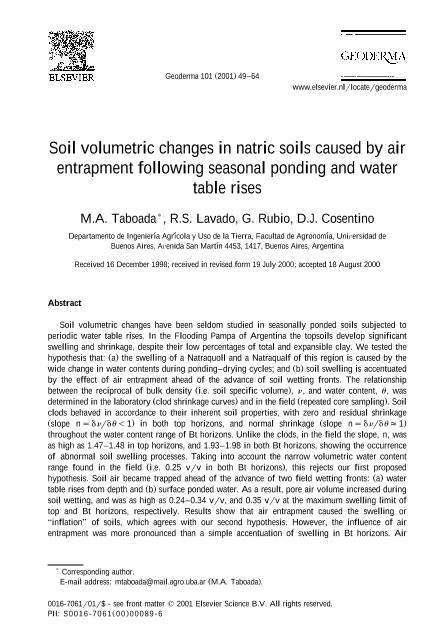Mostrar el registro sencillo del ítem
dc.contributor.author
Taboada, Miguel Angel

dc.contributor.author
Lavado, Raul Silvio

dc.contributor.author
Rubio, Gerardo

dc.contributor.author
Cosentino, Diego

dc.date.available
2018-09-12T16:32:10Z
dc.date.issued
2001-11
dc.identifier.citation
Taboada, Miguel Angel; Lavado, Raul Silvio; Rubio, Gerardo; Cosentino, Diego; Soil volumetric changes in natric soils caused by air entrapment following seasonal ponding and water table rises; Elsevier Science; Geoderma; 101; 3-4; 11-2001; 49-64
dc.identifier.issn
0016-7061
dc.identifier.uri
http://hdl.handle.net/11336/59301
dc.description.abstract
Soil volumetric changes have been seldom studied in seasonally ponded soils subjected to periodic water table rises. In the Flooding Pampa of Argentina the topsoils develop significant swelling and shrinkage, despite their low percentages of total and expansible clay. We tested the hypothesis that: (a) the swelling of a Natraquoll and a Natraqualf of this region is caused by the wide change in water contents during ponding-drying cycles; and (b) soil swelling is accentuated by the effect of air entrapment ahead of the advance of soil wetting fronts. The relationship between the reciprocal of bulk density (i.e. soil specific volume), ν, and water content, θ, was determined in the laboratory (clod shrinkage curves) and in the field (repeated core sampling). Soil clods behaved in accordance to their inherent soil properties, with zero and residual shrinkage (slope n = δν/δθ< 1) in both top horizons, and normal shrinkage (slope n = δν/δθ≈ 1) throughout the water content range of Bt horizons. Unlike the clods, in the field the slope, n, was as high as 1.47-1.48 in top horizons, and 1.93-1.98 in both Bt horizons, showing the occurrence of abnormal soil swelling processes. Taking into account the narrow volumetric water content range found in the field (i.e. 0.25 v/v in both Bt horizons), this rejects our first proposed hypothesis. Soil air became trapped ahead of the advance of two field wetting fronts: (a) water table rises from depth and (b) surface ponded water. As a result, pore air volume increased during soil wetting, and was as high as 0.24-0.34 v/v, and 0.35 v/v at the maximum swelling limit of top and Bt horizons, respectively. Results show that air entrapment caused the swelling or "inflation" of soils, which agrees with our second hypothesis. However, the influence of air entrapment was more pronounced than a simple accentuation of swelling in Bt horizons. Air entrapment caused the whole soil to a depth of about 0.4 m to expand.
dc.format
application/pdf
dc.language.iso
eng
dc.publisher
Elsevier Science

dc.rights
info:eu-repo/semantics/openAccess
dc.rights.uri
https://creativecommons.org/licenses/by-nc-nd/2.5/ar/
dc.subject
Soil Dynamics
dc.subject
Swelling Soils
dc.subject
Volumetric Analysis
dc.subject
Water Flooding
dc.subject
Water Regimes
dc.subject
Water Table
dc.subject.classification
Otras Ciencias de la Tierra y relacionadas con el Medio Ambiente

dc.subject.classification
Ciencias de la Tierra y relacionadas con el Medio Ambiente

dc.subject.classification
CIENCIAS NATURALES Y EXACTAS

dc.title
Soil volumetric changes in natric soils caused by air entrapment following seasonal ponding and water table rises
dc.type
info:eu-repo/semantics/article
dc.type
info:ar-repo/semantics/artículo
dc.type
info:eu-repo/semantics/publishedVersion
dc.date.updated
2018-08-31T13:50:03Z
dc.journal.volume
101
dc.journal.number
3-4
dc.journal.pagination
49-64
dc.journal.pais
Países Bajos

dc.journal.ciudad
Amsterdam
dc.description.fil
Fil: Taboada, Miguel Angel. Universidad de Buenos Aires. Facultad de Agronomia. Departamento de Ingenieria Agricola y Uso de la Tierra; Argentina. Consejo Nacional de Investigaciones Científicas y Técnicas; Argentina
dc.description.fil
Fil: Lavado, Raul Silvio. Universidad de Buenos Aires. Facultad de Agronomia. Departamento de Ingenieria Agricola y Uso de la Tierra; Argentina. Consejo Nacional de Investigaciones Científicas y Técnicas; Argentina
dc.description.fil
Fil: Rubio, Gerardo. Universidad de Buenos Aires. Facultad de Agronomia. Departamento de Ingenieria Agricola y Uso de la Tierra; Argentina. Consejo Nacional de Investigaciones Científicas y Técnicas; Argentina
dc.description.fil
Fil: Cosentino, Diego. Universidad de Buenos Aires. Facultad de Agronomia. Departamento de Ingenieria Agricola y Uso de la Tierra; Argentina. Consejo Nacional de Investigaciones Científicas y Técnicas; Argentina
dc.journal.title
Geoderma

dc.relation.alternativeid
info:eu-repo/semantics/altIdentifier/url/https://www.sciencedirect.com/science/article/pii/S0016706100000896
dc.relation.alternativeid
info:eu-repo/semantics/altIdentifier/doi/http://dx.doi.org/10.1016/S0016-7061(00)00089-6
Archivos asociados
